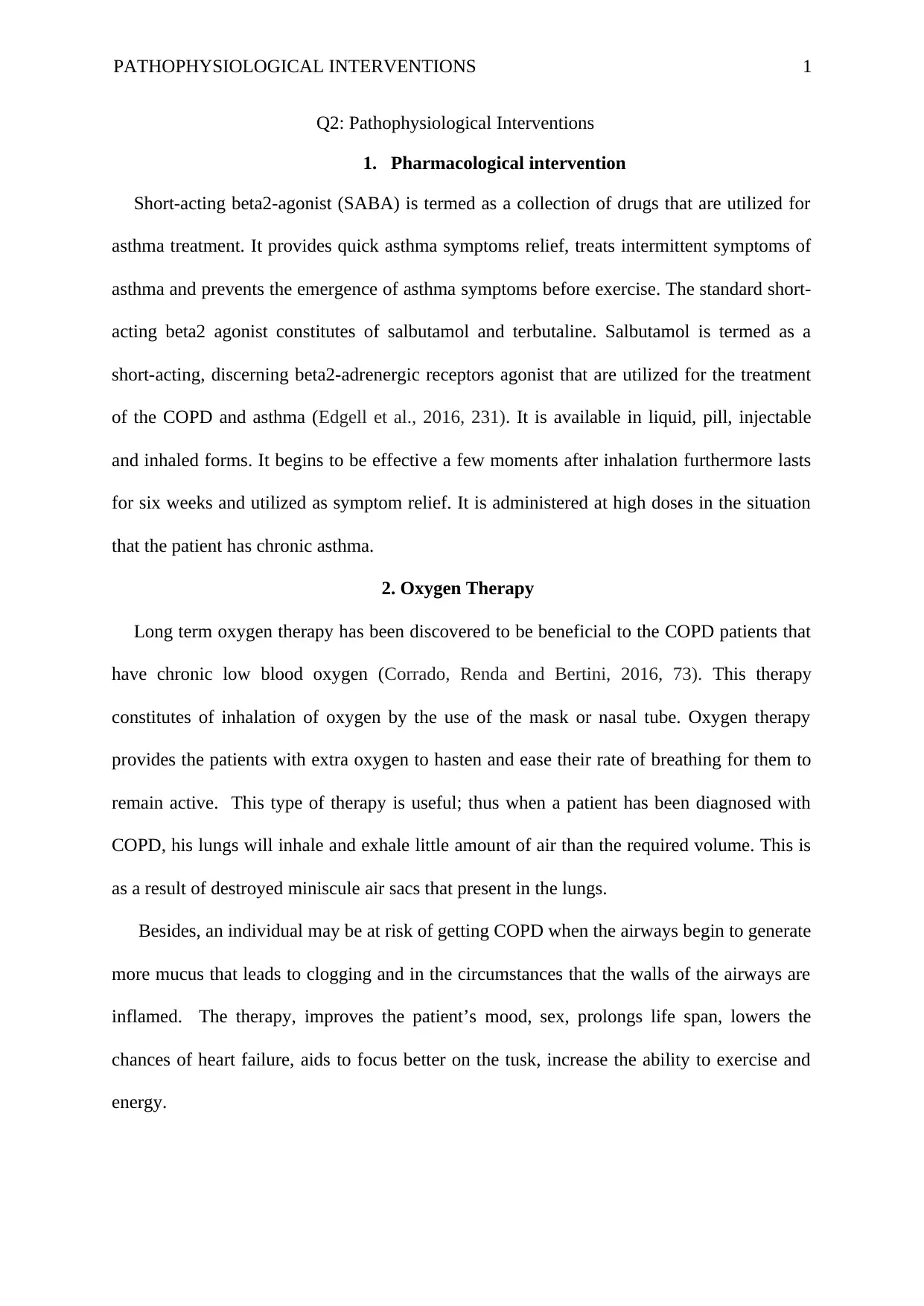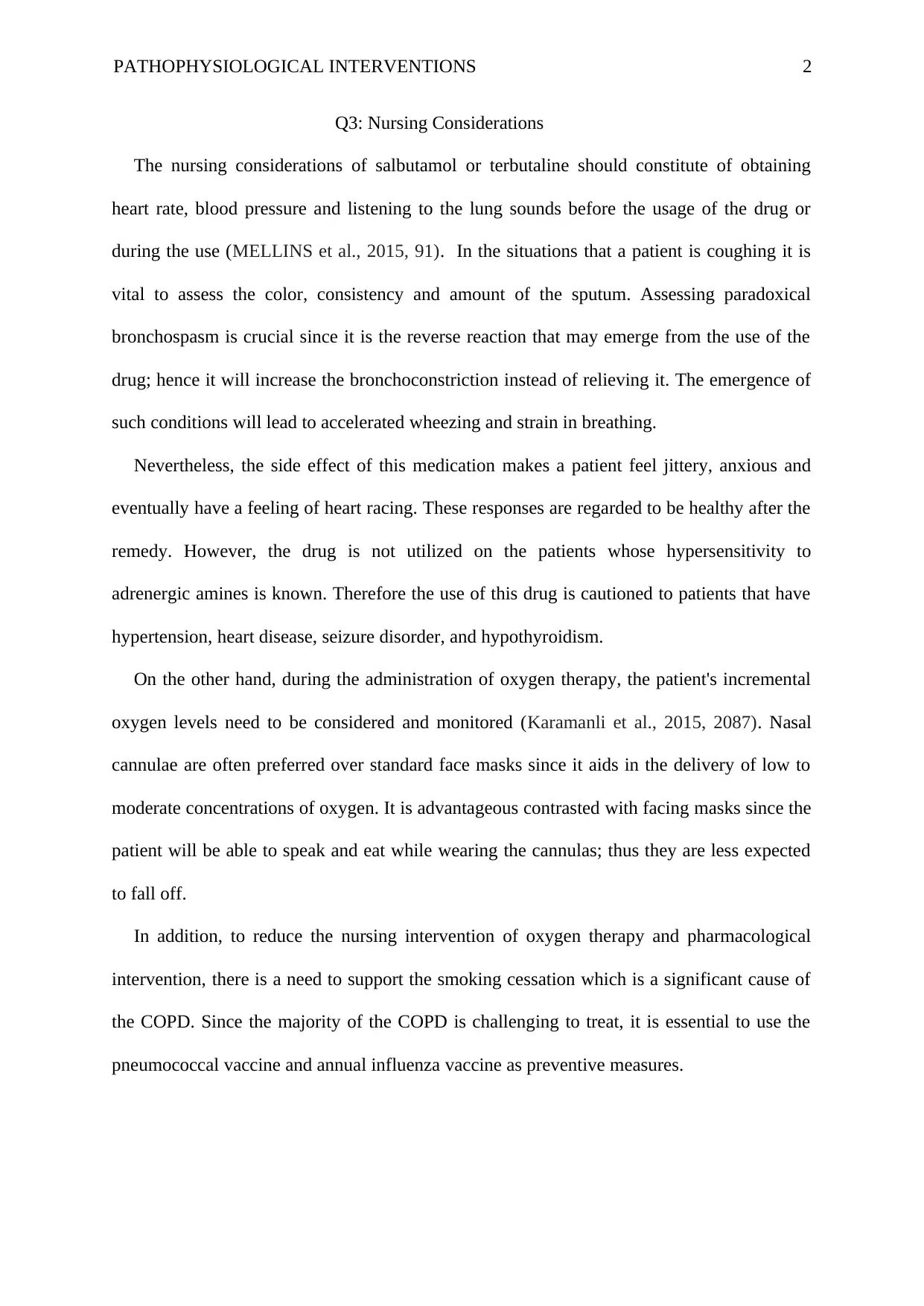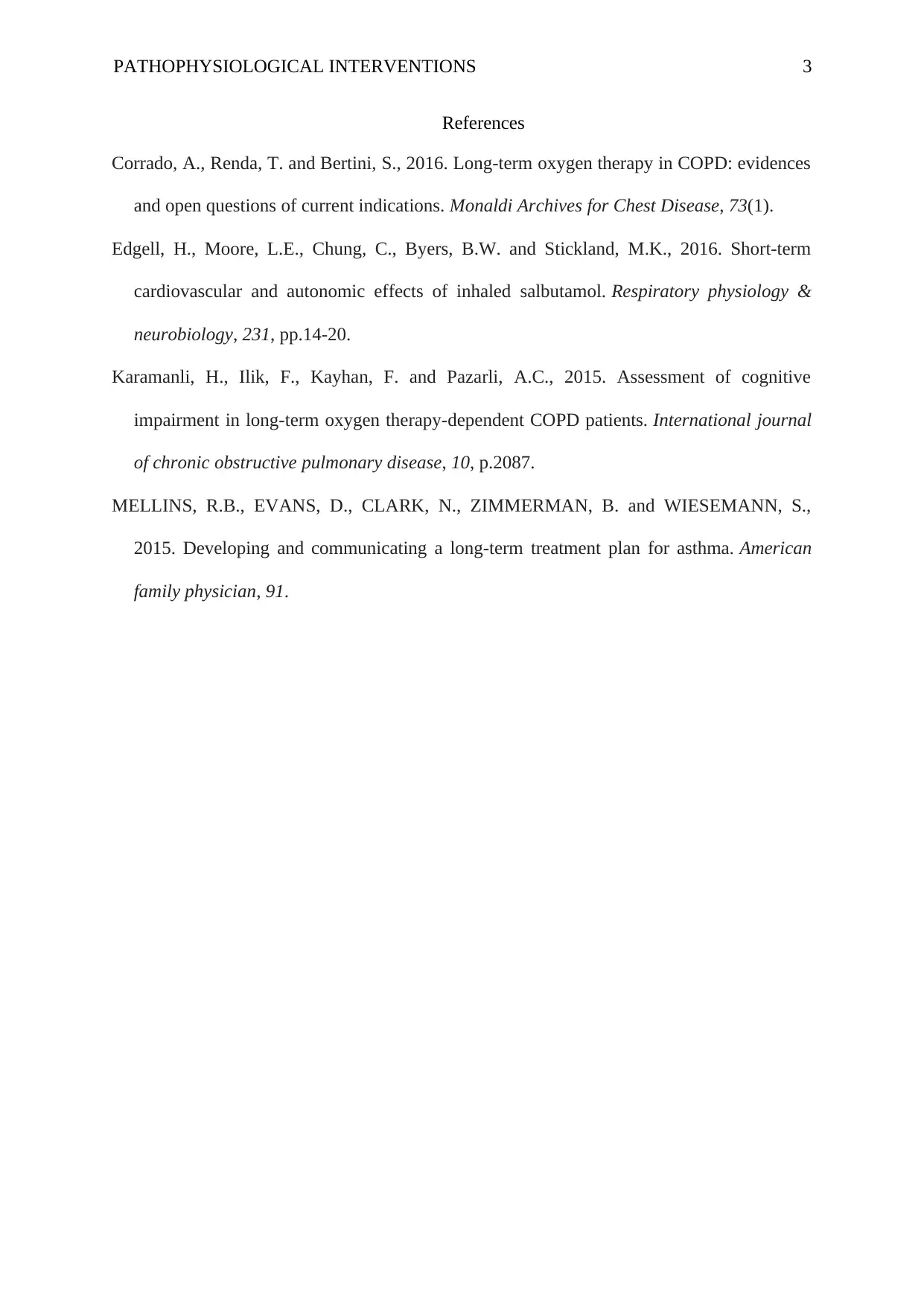Analysis of Pathophysiological Interventions for COPD Patients
VerifiedAdded on 2023/03/21
|4
|872
|59
Report
AI Summary
This report provides an analysis of pathophysiological interventions for Chronic Obstructive Pulmonary Disease (COPD). It delves into pharmacological interventions such as short-acting beta2-agonists (SABA) like salbutamol and the use of oxygen therapy, explaining their mechanisms and benefits in managing COPD symptoms. The report also discusses nursing considerations, including monitoring vital signs, assessing sputum characteristics, and recognizing potential side effects like paradoxical bronchospasm and patient anxiety. Furthermore, it emphasizes the importance of risk reduction strategies, such as smoking cessation support and the use of pneumococcal and influenza vaccines. The content is based on the COPD-X Plan guidelines and supported by reputable references. This report aims to provide a clear understanding of the interventions and nursing roles in COPD management.

Running head: PATHOPHYSIOLOGICAL INTERVENTIONS 0
PATHOPHYSIOLOGICAL INTERVENTIONS
Student’s Name
Pathophysiological Interventions
Institutional Affiliation
Professor’s Name
Course
Topic
Date
PATHOPHYSIOLOGICAL INTERVENTIONS
Student’s Name
Pathophysiological Interventions
Institutional Affiliation
Professor’s Name
Course
Topic
Date
Paraphrase This Document
Need a fresh take? Get an instant paraphrase of this document with our AI Paraphraser

PATHOPHYSIOLOGICAL INTERVENTIONS 1
Q2: Pathophysiological Interventions
1. Pharmacological intervention
Short-acting beta2-agonist (SABA) is termed as a collection of drugs that are utilized for
asthma treatment. It provides quick asthma symptoms relief, treats intermittent symptoms of
asthma and prevents the emergence of asthma symptoms before exercise. The standard short-
acting beta2 agonist constitutes of salbutamol and terbutaline. Salbutamol is termed as a
short-acting, discerning beta2-adrenergic receptors agonist that are utilized for the treatment
of the COPD and asthma (Edgell et al., 2016, 231). It is available in liquid, pill, injectable
and inhaled forms. It begins to be effective a few moments after inhalation furthermore lasts
for six weeks and utilized as symptom relief. It is administered at high doses in the situation
that the patient has chronic asthma.
2. Oxygen Therapy
Long term oxygen therapy has been discovered to be beneficial to the COPD patients that
have chronic low blood oxygen (Corrado, Renda and Bertini, 2016, 73). This therapy
constitutes of inhalation of oxygen by the use of the mask or nasal tube. Oxygen therapy
provides the patients with extra oxygen to hasten and ease their rate of breathing for them to
remain active. This type of therapy is useful; thus when a patient has been diagnosed with
COPD, his lungs will inhale and exhale little amount of air than the required volume. This is
as a result of destroyed miniscule air sacs that present in the lungs.
Besides, an individual may be at risk of getting COPD when the airways begin to generate
more mucus that leads to clogging and in the circumstances that the walls of the airways are
inflamed. The therapy, improves the patient’s mood, sex, prolongs life span, lowers the
chances of heart failure, aids to focus better on the tusk, increase the ability to exercise and
energy.
Q2: Pathophysiological Interventions
1. Pharmacological intervention
Short-acting beta2-agonist (SABA) is termed as a collection of drugs that are utilized for
asthma treatment. It provides quick asthma symptoms relief, treats intermittent symptoms of
asthma and prevents the emergence of asthma symptoms before exercise. The standard short-
acting beta2 agonist constitutes of salbutamol and terbutaline. Salbutamol is termed as a
short-acting, discerning beta2-adrenergic receptors agonist that are utilized for the treatment
of the COPD and asthma (Edgell et al., 2016, 231). It is available in liquid, pill, injectable
and inhaled forms. It begins to be effective a few moments after inhalation furthermore lasts
for six weeks and utilized as symptom relief. It is administered at high doses in the situation
that the patient has chronic asthma.
2. Oxygen Therapy
Long term oxygen therapy has been discovered to be beneficial to the COPD patients that
have chronic low blood oxygen (Corrado, Renda and Bertini, 2016, 73). This therapy
constitutes of inhalation of oxygen by the use of the mask or nasal tube. Oxygen therapy
provides the patients with extra oxygen to hasten and ease their rate of breathing for them to
remain active. This type of therapy is useful; thus when a patient has been diagnosed with
COPD, his lungs will inhale and exhale little amount of air than the required volume. This is
as a result of destroyed miniscule air sacs that present in the lungs.
Besides, an individual may be at risk of getting COPD when the airways begin to generate
more mucus that leads to clogging and in the circumstances that the walls of the airways are
inflamed. The therapy, improves the patient’s mood, sex, prolongs life span, lowers the
chances of heart failure, aids to focus better on the tusk, increase the ability to exercise and
energy.

PATHOPHYSIOLOGICAL INTERVENTIONS 2
Q3: Nursing Considerations
The nursing considerations of salbutamol or terbutaline should constitute of obtaining
heart rate, blood pressure and listening to the lung sounds before the usage of the drug or
during the use (MELLINS et al., 2015, 91). In the situations that a patient is coughing it is
vital to assess the color, consistency and amount of the sputum. Assessing paradoxical
bronchospasm is crucial since it is the reverse reaction that may emerge from the use of the
drug; hence it will increase the bronchoconstriction instead of relieving it. The emergence of
such conditions will lead to accelerated wheezing and strain in breathing.
Nevertheless, the side effect of this medication makes a patient feel jittery, anxious and
eventually have a feeling of heart racing. These responses are regarded to be healthy after the
remedy. However, the drug is not utilized on the patients whose hypersensitivity to
adrenergic amines is known. Therefore the use of this drug is cautioned to patients that have
hypertension, heart disease, seizure disorder, and hypothyroidism.
On the other hand, during the administration of oxygen therapy, the patient's incremental
oxygen levels need to be considered and monitored (Karamanli et al., 2015, 2087). Nasal
cannulae are often preferred over standard face masks since it aids in the delivery of low to
moderate concentrations of oxygen. It is advantageous contrasted with facing masks since the
patient will be able to speak and eat while wearing the cannulas; thus they are less expected
to fall off.
In addition, to reduce the nursing intervention of oxygen therapy and pharmacological
intervention, there is a need to support the smoking cessation which is a significant cause of
the COPD. Since the majority of the COPD is challenging to treat, it is essential to use the
pneumococcal vaccine and annual influenza vaccine as preventive measures.
Q3: Nursing Considerations
The nursing considerations of salbutamol or terbutaline should constitute of obtaining
heart rate, blood pressure and listening to the lung sounds before the usage of the drug or
during the use (MELLINS et al., 2015, 91). In the situations that a patient is coughing it is
vital to assess the color, consistency and amount of the sputum. Assessing paradoxical
bronchospasm is crucial since it is the reverse reaction that may emerge from the use of the
drug; hence it will increase the bronchoconstriction instead of relieving it. The emergence of
such conditions will lead to accelerated wheezing and strain in breathing.
Nevertheless, the side effect of this medication makes a patient feel jittery, anxious and
eventually have a feeling of heart racing. These responses are regarded to be healthy after the
remedy. However, the drug is not utilized on the patients whose hypersensitivity to
adrenergic amines is known. Therefore the use of this drug is cautioned to patients that have
hypertension, heart disease, seizure disorder, and hypothyroidism.
On the other hand, during the administration of oxygen therapy, the patient's incremental
oxygen levels need to be considered and monitored (Karamanli et al., 2015, 2087). Nasal
cannulae are often preferred over standard face masks since it aids in the delivery of low to
moderate concentrations of oxygen. It is advantageous contrasted with facing masks since the
patient will be able to speak and eat while wearing the cannulas; thus they are less expected
to fall off.
In addition, to reduce the nursing intervention of oxygen therapy and pharmacological
intervention, there is a need to support the smoking cessation which is a significant cause of
the COPD. Since the majority of the COPD is challenging to treat, it is essential to use the
pneumococcal vaccine and annual influenza vaccine as preventive measures.
⊘ This is a preview!⊘
Do you want full access?
Subscribe today to unlock all pages.

Trusted by 1+ million students worldwide

PATHOPHYSIOLOGICAL INTERVENTIONS 3
References
Corrado, A., Renda, T. and Bertini, S., 2016. Long-term oxygen therapy in COPD: evidences
and open questions of current indications. Monaldi Archives for Chest Disease, 73(1).
Edgell, H., Moore, L.E., Chung, C., Byers, B.W. and Stickland, M.K., 2016. Short-term
cardiovascular and autonomic effects of inhaled salbutamol. Respiratory physiology &
neurobiology, 231, pp.14-20.
Karamanli, H., Ilik, F., Kayhan, F. and Pazarli, A.C., 2015. Assessment of cognitive
impairment in long-term oxygen therapy-dependent COPD patients. International journal
of chronic obstructive pulmonary disease, 10, p.2087.
MELLINS, R.B., EVANS, D., CLARK, N., ZIMMERMAN, B. and WIESEMANN, S.,
2015. Developing and communicating a long-term treatment plan for asthma. American
family physician, 91.
References
Corrado, A., Renda, T. and Bertini, S., 2016. Long-term oxygen therapy in COPD: evidences
and open questions of current indications. Monaldi Archives for Chest Disease, 73(1).
Edgell, H., Moore, L.E., Chung, C., Byers, B.W. and Stickland, M.K., 2016. Short-term
cardiovascular and autonomic effects of inhaled salbutamol. Respiratory physiology &
neurobiology, 231, pp.14-20.
Karamanli, H., Ilik, F., Kayhan, F. and Pazarli, A.C., 2015. Assessment of cognitive
impairment in long-term oxygen therapy-dependent COPD patients. International journal
of chronic obstructive pulmonary disease, 10, p.2087.
MELLINS, R.B., EVANS, D., CLARK, N., ZIMMERMAN, B. and WIESEMANN, S.,
2015. Developing and communicating a long-term treatment plan for asthma. American
family physician, 91.
1 out of 4
Related Documents
Your All-in-One AI-Powered Toolkit for Academic Success.
+13062052269
info@desklib.com
Available 24*7 on WhatsApp / Email
![[object Object]](/_next/static/media/star-bottom.7253800d.svg)
Unlock your academic potential
Copyright © 2020–2025 A2Z Services. All Rights Reserved. Developed and managed by ZUCOL.





